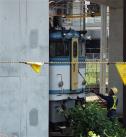
| Home | Open Account | Help | 278 users online |
|
Member Login
Discussion
Media SharingHostingLibrarySite Info |
International Railroad Discussion > Shin-Kawasaki and Shin-Tsurumi (Japanese Freight)Date: 06/02/15 19:50 Shin-Kawasaki and Shin-Tsurumi (Japanese Freight) Author: cchan006 I did a little foaming at Shin-Kawasaki (新川崎) after I finished chasing JR Freight Train #3086.
Shin-Kawasaki Station is on the JR Yokosuka Line (横須賀線), and right next to the station is Shin-Tsurumi Signal Point (新鶴見信号場). This location was a freight yard until 1984 when it ceased to be one due to JNR reforms to cut costs. Some of the yard tracks still remain, and they are used to stage freight trains while crew and locomotive changes take place. In the first clip, I'm riding a Shonan-Shinjuku Line train from Shinjuku. The train travels on the Yokosuka Line tracks after Osaki (大崎), and I knew from experience that there's a segment where it travels along the Tokaido Shinkansen, so I got my video camera out and started recording. My train meets a Yokosuka Line train, and seconds later, a 700 Series Shinkansen. Distortion from CMOS sensor's "rolling shutter" is apparent. In the second clip, I run into Train #3064 once again, the same one I saw at Nasu-Shiobara (那須塩原) earlier in the day, seen getting "passed" by a Shinkansen in the video I posted earlier. Unlike the #3086, #3064 took the "normal" route via Musashino and Nanbu Lines, so it did not go through Shinjuku. The locomotive remains the same, EF66-100 (~5200 hp). I suspect the locomotive change didn't take place, because the train's destination is Tokyo Freight Terminal, which is only a short hop away. The crew change probably did take place, and the engineer gives the well-dressed railfan and me a gentle "highball the foamer" for each of us. I believe Train #72 is seen in the third clip, a shuttle between Sumidagawa Freight Terminal (in NE Tokyo) and Tokyo Freight Terminal. Locomotive is the classic ~3400 hp EF65, which was manufactured between 1969 and 1978. There's a warning announcement for a passing train at the beginning, and it is seen near the end of the clip, a Shonan-Shinjuku Line E233 EMU speeding by. - EH500 "Kintaro" locomotive is in the foreground. Behind it is an EH200 "Blue Thunder" articulated DC locomotive, ~6000 hp. - Classic EF66 is in the foreground, in the original style carbody. Railway Museum in Omiya has one on display. Another EH500 is beside the EH200.   You must be a registered subscriber to watch videos. Join Today! Date: 06/02/15 20:02 Re: Shin-Kawasaki and Shin-Tsurumi (Japanese Freight) Author: cchan006 There's a road that goes over the yard at Shin-Kawasaki to get a decent view of Shin-Tsurumi. Unfortunately, it's tough to shoot through the fence on the north side, so I had to dangle my camera above it and hoped for the best (previous two shots of the locomotives).
- Here's a view from the overpass to the south. Here, there's no fence to shoot over, just safety glass, so it was much easier to get this shot. From left to right: EF210 "Momotaro", and a pair of EH200 "Blue Thunder" locomotives, then a EF64 which is the closest one. EF64 is similar in appearance and performance to the EF65, the most notable difference being the arrangement grilles and windows on the long hood. - EF65 under the overpass, being washed.   Date: 06/04/15 07:22 Re: Shin-Kawasaki and Shin-Tsurumi (Japanese Freight) Author: Torisgod Wow, what an amazing thread! I didn't know anything about Japanese freight trains before now. The surprise at the end of your video was great. Don't all the non-Shinkansen trains use a narrow gauge in Japan?
Tor in Eugene Date: 06/05/15 20:17 Re: Shin-Kawasaki and Shin-Tsurumi (Japanese Freight) Author: cchan006 Torisgod Wrote:
------------------------------------------------------- > Wow, what an amazing thread! I didn't know > anything about Japanese freight trains before now. > The surprise at the end of your video was great. > Don't all the non-Shinkansen trains use a narrow > gauge in Japan? > > Tor in Eugene Most (but not all) conventional non-HSR JR Lines are 1067 mm (3' 6") gauge, which is "narrow" gauge, but Japanese consider that their "standard" gauge. However, the lines that host the non-HSR segment of Yamagata and Akita Shinkansens (nicknamed "mini Shinkansen") run conventional EMUs on 1435 mm (4' 8.5") gauge. There are numerous non-JR private railways that use gauges other than 1067 mm, including 1372 mm (4' 6") on the Keio Line (京王線) in Tokyo. 1435 mm is used on the Keisei Line (京成線), which goes to Narita Airport. There are other examples, but maybe another time, another thread. JR Freight trains run only on 1067 mm gauge, which probably answers your question. |